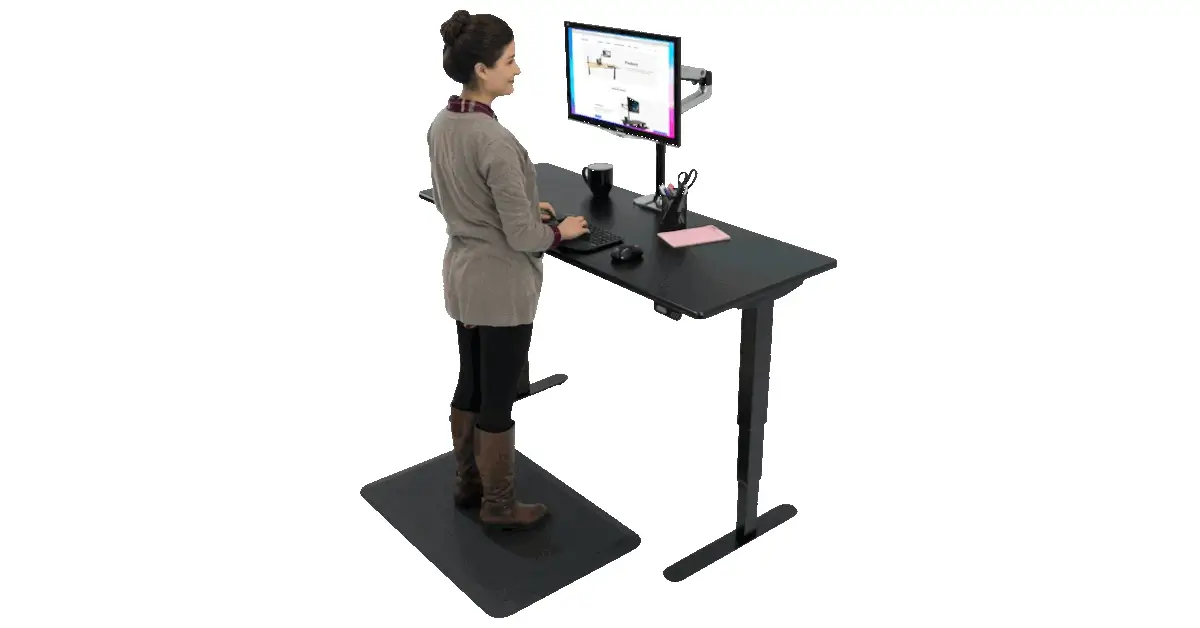There’s a relatively new alternative to the typical workstation. Instead of sitting for hours at a time, employees are standing while they work.
Research shows that many workers who sit at a desk for long periods of time develop nagging back pain or neck pain. An increasing number of workers have begun using a stand-up or standing desk, at least for part of their workday, to break up the potential problems from prolonged sitting. But are they really worth it? Let’s take a look…
Reviewing the Studies
The U.S. Centers for Disease Control and Prevention released a study in 2011 that determined when standing desks were in use and workers decreased their sitting time by about an hour a day, they reduced their upper back and neck pain by 54 percent. They also experienced improvements in mood.
Experts say that working at a standing desk instead of sitting can reduce the risk for a number of other health conditions, including obesity, type 2 diabetes, cardiovascular disease and cancer. A study published in the American Journal of Epidemiology and conducted by researchers at the American Cancer Society suggests people who sit for long periods of time have an increased risk of disease and a shorter average life span.
A 2014 study in the International Journal of Environment Research and Public Health found that providing workers with combination sit-stand desks reduced their sedentary time by more than three hours a week. It also increased their sense of well-being and energy, while decreasing fatigue and appetite. There was even one test done by a company that showed standing desks improved productivity by up to 10 percent.
Standing Desks: Pros and Cons
Thankfully, for true believers, the field of ergonomics came up with standing desks. The idea of using standing desks has been around for quite some time. As early as the 18th century, standing desks were already widely used in the offices and homes of the wealthy.
Pros
There are plenty of reasons why standing desks are great for spine health. For starters, they keep you on your feet while you go about your day-to-day tasks. That alone already results in health benefits; standing enables you to straighten your posture, speed up your metabolism and burn extra calories. But just as important, the act of standing improves posture and engages the postural muscles in a way that sitting cannot accomplish. While sitting, it is much easier to slouch, which creates weak neck and back muscles. But when you are standing, it enables the neck, back, and hip muscles to activate, thereby preventing the muscles from weakening.
Cons
However, standing to work has also been known to be potentially problematic. Using a standing desk won’t eliminate all your aches and pains. More likely, a different group of muscles will start to hurt. People who sit for much of their work life complain of sore shoulders, neck and upper back pain. But standing up for the entire day impacts a different muscle group altogether. Standing desk aficionados tend to experience more pain in the lower back, legs and feet.
And here’s the true downside of standing: It is more tiring. For men with ischemic heart disease, it increases the progression of carotid atherosclerosis (a narrowing of arteries in the neck) because of the additional load on the circulatory system. Prolonged standing at work also increases the risks of varicose veins. So standing all day is actually unhealthy, too.
Standing Desk: General Verdict
Whether you sit or stand, your body must have variance to be healthy. Some standing can be good, but it’s important to transition properly to the use of a standing desk. First, don’t jump right into standing. You should gradually increase the amount you stand and decrease the amount you sit until you hit a comfortable balance.
The Pregnancy Variable
Pregnancy adds a wrinkle to the standing desk controversy. Excess sitting is problematic for pregnant women due to the same reasons outlined above. However, their changing physiology during pregnancy can make standing risky, too.
Studies have also shown that standing while pregnant is associated with smaller infant head size. Standing can increase the risk of varicose veins in pregnant women and carotid atherosclerosis. So use of a standing desk should be limited and monitored by your doctor.
In addition, whether at a desk or otherwise, if you are pregnant and you must stand for long periods of time, put one of your feet up on a footrest, low stool or box. This helps by reducing the curvature in the lower back. Switch feet every so often and take frequent breaks. Wear comfortable shoes with good arch support. Consider wearing support hose, too.
Walking and exercise are still preferable to standing or sitting for long periods of time. It might be worth considering a treadmill desk, if possible.
Bottom line: Mix it up and make movement an important part of your day.

